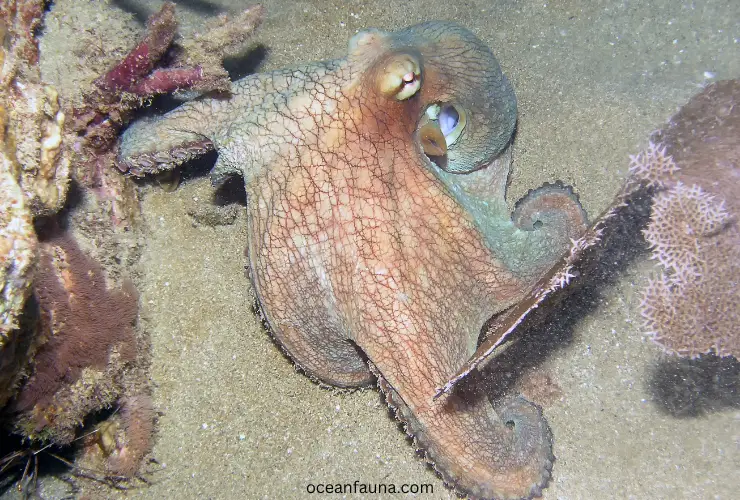Meet the Caribbean Reef Octopus – a marine animal that inhabits coral reefs. It has eight long arms that differ in size and width. The mantle is bulky and can reach up to 60 cm in length. It weighs approximately 3.3 lb or 1.5 kg.
This species is hard to describe because it can alter its color and texture by using specific skin cells called chromatophores. Its color range is vast, ranging from red to green and from rough to smooth. Furthermore, it is a master of disguise, using its shape-shifting abilities to blend in with its surroundings and avoid predators.
Have you ever wondered how this creature could adapt and blend so seamlessly with its surroundings, almost to the point of becoming invisible? If you have, then you are in for a treat with this article on the “Caribbean reef octopus”. Dive into the sea of insights and discover the fascinating world of this intelligent and shape-shifting octopus.
About Caribbean Reef Octopus: A Quick Biology
Curious to know more about the biology of the Caribbean reef octopus? Take a look at the quick facts table below and learn fascinating information about this incredible marine beast.
| Parameters | Details |
| Scientific name | Octopus briareus (Robson, 1929) |
| Kingdom | Animalia |
| Family | Octopodidae |
| Genus | Octopus |
| Phylum | Mollusca |
| Class | Cephalopoda |
| Order | Octopoda |
| Species | O. briareus |
| Habitat | It inhabits many reefs and grass beds throughout the western Atlantic, Bahamas, Caribbean, and northern South America. |
| Life Span | 1 to 1.5 years |
| Diet | Invertebrates, clams, large marine snails, crabs, lobsters, and many more preys |
| Geography | The Nearctic region, Neotropical region (Central and South America), oceanic islands, and the Pacific Ocean |
| Weight | weighs around 3.3 lb or 1.5 kg |
| Length | 120 mm (as big as 12cm and with arms as long as 60cm) |
| Predators | Sharks, Stingrays, Large Fish |
Fun Facts about the Caribbean Reef Octopus
Here are a few fun facts about the Caribbean reef octopus:
- It can be incredibly difficult to spot a Caribbean reef octopus that is using camouflage. These animals are experts at blending in with their surroundings, making them nearly invisible to the human eye.
- The Caribbean reef octopus is a small species, with a mantle size of only 5 to 12 cm.
- These octopuses can change the color of their skin to blend into their surroundings, as well as to communicate with other members of their species.
- This species is monogamous and mates only once in its lifetime.
- Caribbean reef octopuses have several physical adaptations that enable them to catch their prey, including web-like arms, seven rows of teeth, and suckers.
- Octopuses of certain species can use their arm webbing like a parachute to catch prey.
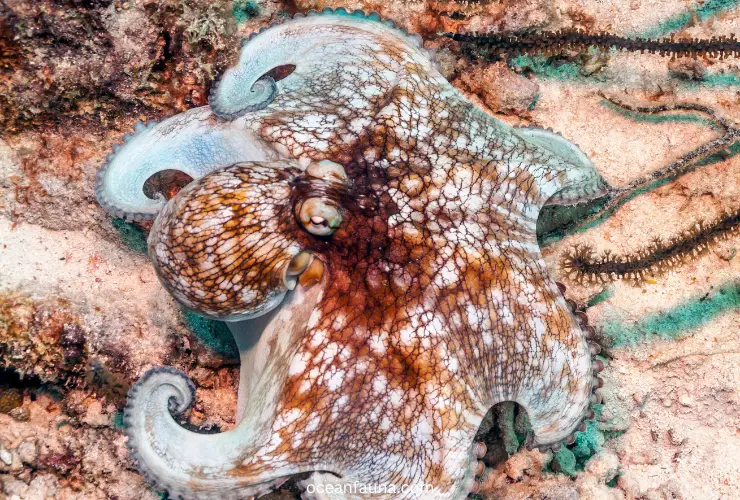
Etymology and History of Caribbean Reef Octopus
The etymology of the Caribbean reef octopus has a rich history. It is a fascinating example of how scientific names can tell us about a species’ biology, behavior, and cultural significance. Let us see what does SciELO organization said about it:
“The word “octopus” is derived from the Greek word “októpous,” which means “eight-footed.” The word “Caribbean” refers to the region in which the species is found. The name “reef” refers to the octopus’s habitat, which is in coral reefs. And what’s its scientific name?
The Latin name for the Caribbean reef octopus is “Octopus briareus,” which is believed to be derived from Briareus, one of the three giant sons of Uranus and Gaea in Greek mythology. The name Briareus means “strong” or “vigorous.” The name is fitting for the Caribbean reef octopus, which is a strong and intelligent creature that can adapt and blend into its surroundings with ease.”
The researchers further added information about its historical facts: “Scientific divers recently discovered an Octopus briareus specimen near Port Sisal, Yucatán, Mexico in 1929. This is the first time that O. briareus has been observed in the southern Gulf of Mexico. It expanded the known westernmost distribution area for this species on the American continent.
The adult female octopus weighed 25.3 g and was captured during routine maintenance at underwater facilities. The species’ appearance in this area may be due to changes in the environmental conditions of the Caribbean Sea and the Gulf of Mexico.”
How Does Carribean Reef Octopus Look?
The authors from the SciELO organization have described these physical characteristics of the Caribbean reef octopus:
“The Caribbean reef octopus is known for its amazing ability to change its color and texture to blend in with its surroundings. It makes it difficult to describe the physical appearance. Its color range is very broad, and it can change from red to green and from bumpy to smooth. This octopus has eight long arms that vary in length and diameter.
It has a large, chunky mantle that can reach up to 60 cm in length. Also, its weight is around 3.3 lb or 1.5 kg. It is a master of disguise, using its shape-shifting abilities to avoid predators. Males and females look alike, except for a modified arm called the hectocotylus, which is necessary for reproduction.”
According to the study that talks about the dokie physical characteristics of octopus briareus:
- Caribbean reef octopuses have distinct dark eyes (red-brown). It also has a mantle size that ranges from 54 mm to 120 mm.
- On average, these octopuses weigh 1 kg. Their youngsters have arms of 7-9mm. They also have a mantle of 5.5mm. It resembles small adults.
- The Caribbean reef octopus has eight arms. The longest arms are second and third one. These can grow five times longer than the length of its mantle.
- Seven rows of teeth and two rows of these octopus suckers on each arm, linked by loose webs, allow these octopuses to hunt effectively.
- Males have a hectocotylus on the right third number arm that can deposit spermatophores, which contain sperm for mating.
These unique physical features make it a fascinating and distinct species of octopus.
| Parameters | Details |
| Average mass | 1 kg (2.20 lb) |
| Range length | 120 (high) mm (4.72 (high) in) |
| Average length | 54 mm (2.13 in) |
| Other Physical Features | ectothermic; bilateral symmetry |
| Sexual Dimorphismsexes | Sexes shaped differently |
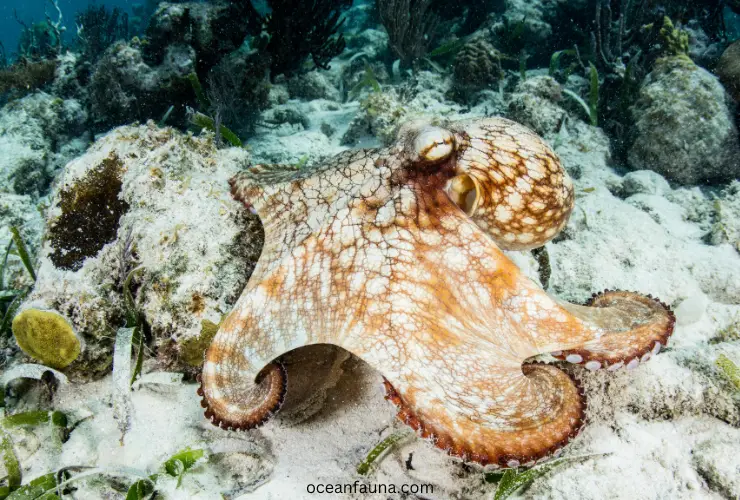
Habitat and Distribution of Caribbean Reef Octopus
According to a study, “Not much is known about the biological and ecological aspects of O. briareus. However, it is found in a wide area from southern Florida to the northern coast of South America. It could possibly be found in the southern Gulf of Mexico, but there is no record of it being there yet.”
However, let’s see what the study talk about its habitat and distribution:
“The Caribbean reef octopus prefers warm waters and is found in coral reef environments, as well as grassy and rocky sea beds. Its biogeographic regions span the Nearctic and Neotropical regions, including Central and South America, as well as oceanic islands and the Pacific Ocean.”
The study further added, “The Caribbean reef octopus prefers to live in secluded and obscure rocky hideouts in shallow, warm waters.” This makes them challenging to discover. Being a solitary creature, the Octopus briareus remains distant from others of its species, except when mating.
When threatened by predators, the Caribbean reef octopus, like most other octopuses, expels a swift jet of water to swiftly propel itself away. It can also release ink to hide its escape. Unlike spending its entire life in its hiding place, this octopus moves frequently, except when nurturing its offspring.”
| Parameters | Details |
| Habitat regions | tropical; saltwater or marine |
| Aquatic Biomes | reef; coastal |
| Range depth | 3 to 20 m9.84 to 65.62 ft |
What Do Caribbean Reef Octopus Eat?
The Caribbean reef octopus is a carnivorous predator that feeds on a variety of prey. Its diet primarily consists of crustaceans, fish, and mollusks. It uses its suction cups and sharp beak to catch and consume its prey. The octopus is a skilled hunter and uses its camouflage tactics to ambush unsuspecting prey.
An internet study has given the following as prey of the Caribbean Reef Octopus, “The Caribbean reef octopus is a nighttime hunter. It eats crabs, shrimp, lobsters, polychaetes, and different kinds of fish. It preys on juvenile Caribbean spiny lobsters, making it an intraguild predator.”
Oceana organization has found the following facts about the dietary lifestyle of this specie, “The Caribbean reef octopus is a predatory species that hunts for food on coral reefs in the Caribbean Sea. They have a varied diet consisting mainly of invertebrates, with a particular preference for clams, large marine snails, crabs, and lobsters.
These creatures have also been known to engage in cannibalism, particularly after defending their territory against an intruder of the same species. The majority of hunting activities take place at night when the octopus can move around the reef without fear of being attacked by predators.”
The food consumption of octopuses is influenced by various factors, such as:
- Food availability
- Water temperature (higher temperatures encourage more feeding)
- Pregnancy status
A female octopus typically reduces her food intake by half two weeks before laying her eggs.
What Is the Reproduction System of Caribbean Reef Octopus
Have a look at the table for a quick review:
| Parameters | Details |
| Main Reproductive Features | semelparous, sexual, fertilization (internal), oviparous, sperm-storing |
| The intervals of breeding | These octopuses breed only once in their entire lifetime. |
| The seasons of breeding | Although octopuses breed year-round, spawning peaks around February-March. Most breed between six months to a few years after they reach maturity. |
| number of offspring | 200,000 (high) |
| Average gestation period | 65 days |
| Average time to independence | 0 minutes |
| The average age at sexual or reproductive maturity (female) | 5 months |
| The average age at sexual or reproductive maturity (male) | 5 months |
Let’s see the reproduction system of this special octopus:
- The mating season of the Caribbean reef octopus typically occurs during January and lasts for one to two months.
- The male and female octopuses of this species do not exhibit physical differences. What does it mean? It means they do not display dimorphism.
- During mating, the male initially mounts the female’s mantle and then inserts his hectocotylus. Hectocotylus is an arm that serves as a “tube” for the transfer of sperm into the female’s oviduct. This process usually takes around 30 minutes and occurs during the day.
- Only the male octopus can initiate or halt the mating process.
- When it comes to reproduction, Caribbean reef octopuses mate through internal fertilization.
- Once the female octopus has been fertilized, she can store the sperm in her oviduct for a maximum of 100 days.
- After the female locates a suitable hiding place, she deposits her eggs. Some females have been observed to seal themselves within their lair while pregnant.
- A female octopus can lay up to 500 eggs. These eggs are attached to one another through unique stalks.
- The female remains with her eggs until they are ready to hatch. She fiercely defends them against any approaching creatures. However, if she kills the predator, she will not consume it.
- The eggs typically hatch in 50 to 80 days. The warmer water temperatures can cause a quicker incubation period.
- The newly hatched octopuses can propel themselves through water and secrete ink, similar to their parents.
- Within 14 weeks, the hatchlings are approximately 75% of their full-grown size. Males reach sexual maturity in about 140 days, while females do so in around 150 days.
This is their complete reproduction system and lifecycle.
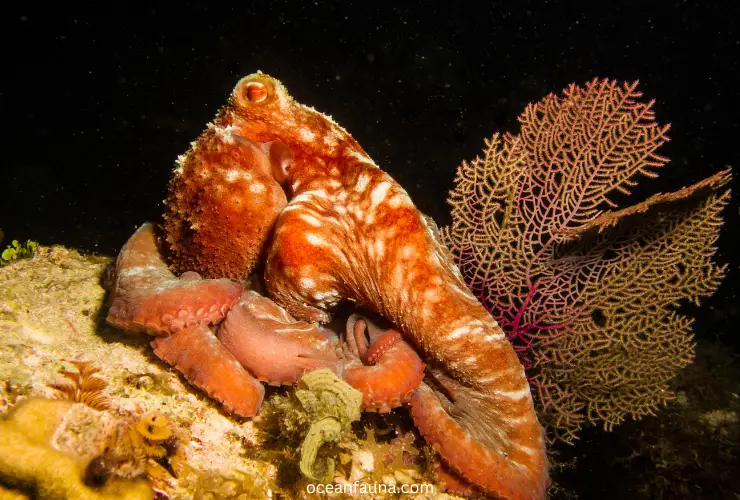
Behavior of Caribbean Reef Octopus
Caribbean Reef Octopus has the following common behaviors:
- Solitary behavior: Caribbean reef octopuses prefer to live in the lonely dens near coral reefs. They typically do not interact with other octopuses except for mating. So, they are considered solitary creatures.
- Territorial behavior: Caribbean reef octopuses are best known as territorial. They protect their dens and the other surrounding areas from predators and other octopuses. They can be aggressive towards intruders, even killing and eating them if necessary.
- Nocturnal behavior: Being nocturnal, Caribbean reef octopuses are active at night. This behavior provides them protection from killer predators and enables them to approach their prey stealthily.
- Monogamous behavior: Caribbean reef octopuses are also known monogamous. They mate with one female and one male. Their mating process does not involve a specific ritual. However, the male can either mount the female or transfer his hectocotylus to the female, which she stores and later uses to fertilize her eggs internally.
- Motile and sedentary behavior: Caribbean reef octopuses communicate through various means. They have a specific vocalization. It is known as a perfect match of sender-receiver that is unique to their species. Additionally, they use chromatophores in their skin to create intricate patterns. These are easily understandable for other octopuses. Another communication method is the use of iridocytes located in their skin, which produce reflective signals to communicate with other octopuses.
Hope you like reading about the innovative behaviors of this special but strange octopus.
The Intelligence of Caribbean Reef Octopus
The Caribbean Reef Octopus is a highly intelligent species of octopus found in the warm waters of the Caribbean Sea. This animal can solve complex problems and exhibits remarkable learning capabilities. It can change color and texture to blend in with its surroundings and even communicate with other octopuses through a system of visual and tactile signals.
Additionally, the Caribbean Reef Octopus has been observed using tools in the wild, such as carrying coconut shells to use as shelter or protection. Their intelligence and adaptability have helped them survive and thrive in their oceanic habitat. Researchers continue to study the cognitive abilities of the Caribbean Reef Octopus to understand their intelligence better.
Cardiovascular and Nervous System
Cardiovascular system
- The cardiovascular system of the Caribbean Reef Octopus consists of a three-chambered heart.
- Two branchial hearts pump blood to the gills, where it is oxygenated.
- The systemic heart then pumps the oxygenated blood to the rest of the body.
- The octopus also has a closed circulatory system, which means that blood flows through vessels and doesn’t directly bathe the organs.
Nervous system
- The nervous system of the Caribbean Reef Octopus is highly developed and complex.
- It includes a centralized brain and a distributed nervous system throughout its eight arms.
- The octopus is known for its remarkable intelligence and problem-solving ability, which is partly due to its complex nervous system.
- It also has a high degree of control over its movements and can even change its skin color and texture to blend in with its surroundings.
Thus, it possesses a unique and sophisticated cardiovascular and nervous system, allowing it to thrive in its marine environment.
Predators of Caribbean Reef Octopus
According to the study, “the Caribbean reef octopus is a food source for many of the larger bony fish and sharks that inhabit the reef. These predators often prey on the octopus, making it an important part of the food chain on the coral reef ecosystem.”
Caribbean Reef Octopus has the following predators, according to Animal Diversity organization’s researchers:
- Killer sharks
- Large fish
- Birds like eagles
- Eels, usually bigger eels
- Humans
- Other species of octopuses
- Dolphins
- Bigger Whales
Overall, Caribbean reef octopuses face numerous natural predators and also human threats.
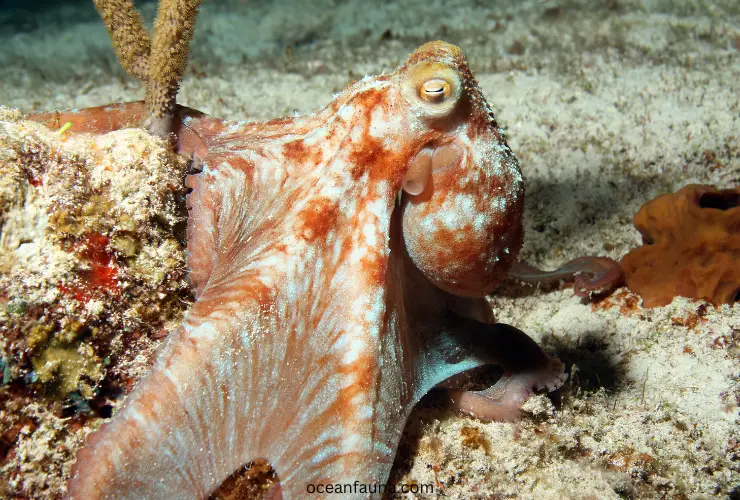
The Ink of Caribbean Reef Octopus
Caribbean reef octopuses have a unique defense mechanism that they use to evade predators. They are capable of releasing a cloud of dark ink when faced with an oncoming threat. This ink serves two purposes:
- Firstly, it obscures the octopus’s escape route, making it harder for the predator to follow.
- Secondly, the ink has an unpleasant taste, which can discourage the predator from continuing its pursuit of the octopus.
Overall, this strategy allows the Caribbean reef octopus to effectively defend itself against potential predators in the wild.
Threats to Caribbean Reef Octopus
The Caribbean reef octopus is not caught for commercial fishing, but it is still taken by artisanal fishers, which has led to depletion in certain areas. The overall population trends for this species are unknown, but local fishing activities could potentially threaten its survival.
The Caribbean reef octopus is not typically dangerous to humans. It is a shy and reclusive creature that usually tries to avoid contact with humans. However, like all octopuses, it does have a beak that can deliver a painful bite if it feels threatened. Additionally, some species of octopuses carry venom that can be dangerous to humans.
Here are a few other potential threats to the Caribbean reef octopus:
- Habitat destruction – Coastal development and other human activities can lead to the destruction or degradation of coral reefs. It can negatively impact the octopus’s habitat and food sources.
- Pollution – Pollution from coastal runoff or other sources can cause harmful algae blooms or other disruptions to the ecosystem. It can be detrimental to the octopus and its prey.
- Climate change – Rising ocean temperatures, ocean acidification, and other climate-related impacts can have negative effects on the octopus’s habitat and prey. It can potentially lead to declines in population size.
- Bycatch – Caribbean reef octopuses can be caught unintentionally as bycatch in fishing gear meant for other species, which can have negative impacts on their population size.
- Unsustainable tourism – Uncontrolled tourism can lead to damage to coral reefs and the removal of octopuses from their natural habitat. Additionally, handling octopuses can cause stress or physical harm to the animals, further contributing to population declines.
Climate change, overfishing, and other factors can all negatively impact the health of coral reefs, and thus the survival of the Caribbean reef octopus. Any disruptions to the delicate balance of this ecosystem could potentially pose a risk to the species.
Conservation Status of Caribbean Reef Octopus
Caribbean reef octopuses have not yet been evaluated for the Red List of ICUN. They do not have a special status on any official list, including the U.S. Federal List, State of Michigan List, or CITES. While there are no significant threats to the species, minor threats include harvesting by humans for food, research, and the pet trade.
In addition to the above, bacterial infections such as Vibrio parahaemolyticus, Vibrio damsela, and Pseudomonas stutzeri are major threats. These can cause ulcers, which are common when these octopuses are kept in close captivity.
Are Caribbean Reef Octopuses Venomous?
Yes, Caribbean Reef octopuses are venomous. They use their beaks and radula to rip their prey apart. They also employ their salivary papilla, which acts like a tiny drill, to inject venom that aids in paralyzing their prey. Venom can also be used as a defense mechanism against predators.
The venom contains a complex mixture of biologically active compounds. These mixtures include enzymes, proteins, and other molecules that can induce paralysis or cause tissue damage. The potency and effects of the venom vary depending on the species of octopus and the victim’s potential and size.
What Adaptations Does The Caribbean Reef Octopus Have?
The Caribbean reef octopus has several adaptations that help it survive in its environment. It has a complex nervous system, which helps it to respond quickly to danger and catch prey. Additionally, it has eight arms with suction cups that help it grip surfaces and catch food. These adaptations make the Caribbean reef octopus a skilled predator and a master of disguise.
Anti-Predator Adaptations
Octopuses possess various anti-predator adaptations:
- They have the instinct to flee and can squeeze into tight spaces, giving them an advantage over larger predators.
- They release ink from a gland to create a dark cloud, enabling them to escape under cover of darkness.
- They can change the color of their skin to blend into their surroundings, making them difficult to detect.
- They can also mimic larger animals by altering their body shape, which helps them intimidate and deter predators.
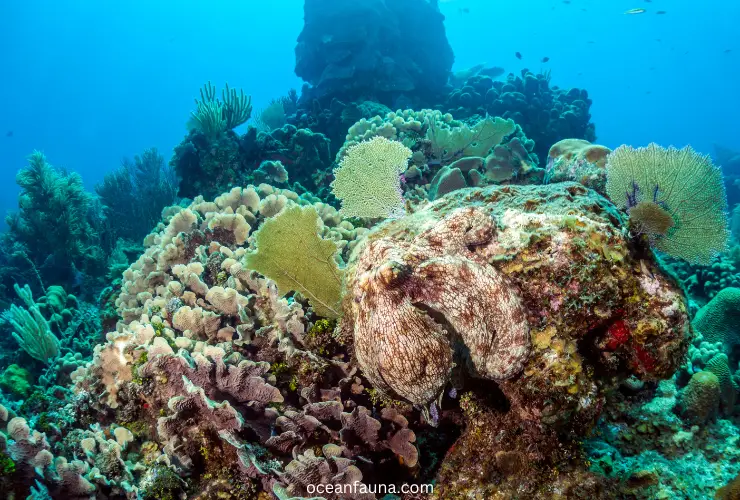
FAQs
What is the lifespan of a Caribbean Reef Octopus?
The lifespan of a Caribbean Reef Octopus is generally one to two years, but in captivity, they can live for up to three years.
Conclusion
The Caribbean Reef Octopus is a true wonder of the sea. From their incredible intelligence and adaptability to their stunning displays of color and movement, they are a marvel to behold. As one of the ocean’s most fascinating creatures, they remind us of the vast and mysterious world that lies beneath the waves. It also recalls us of the importance of preserving it for future generations to appreciate and admire.

